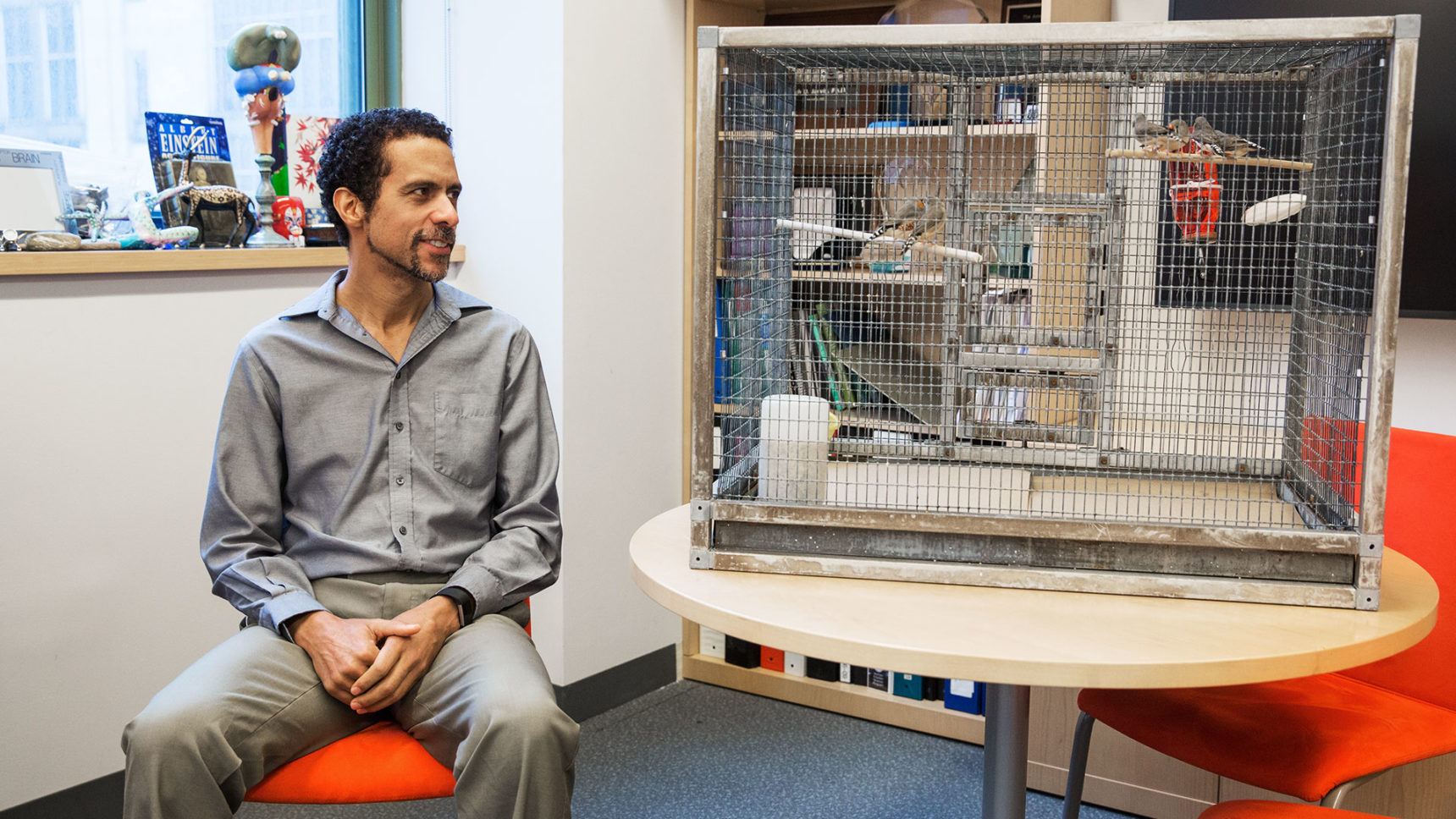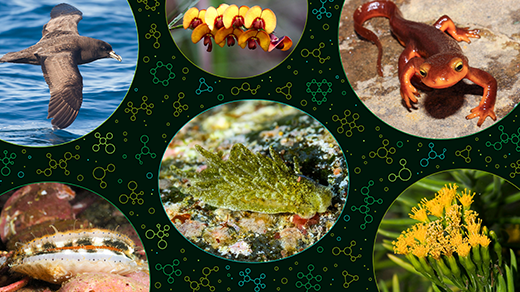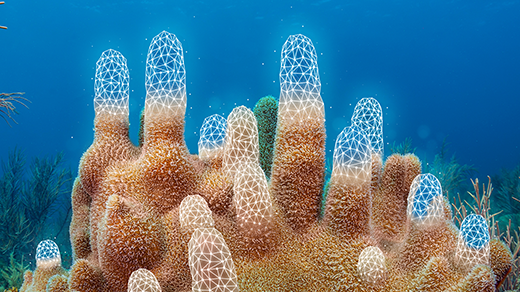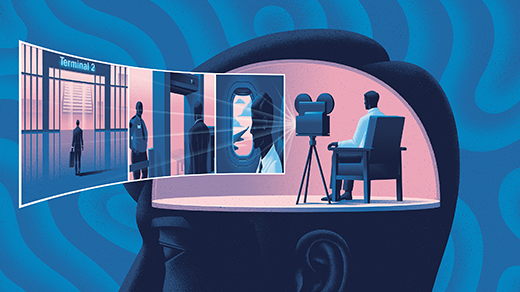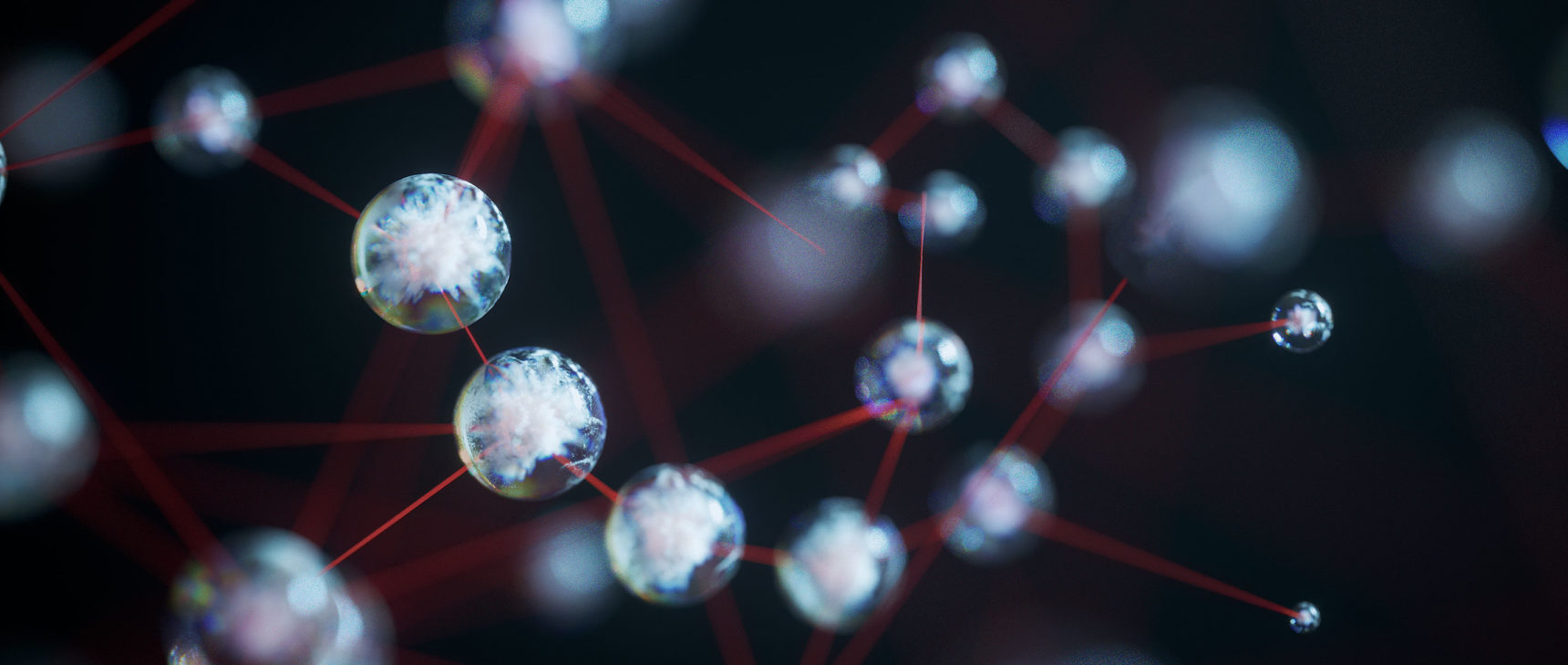In Birds’ Songs, Brains and Genes, He Finds Clues to Speech
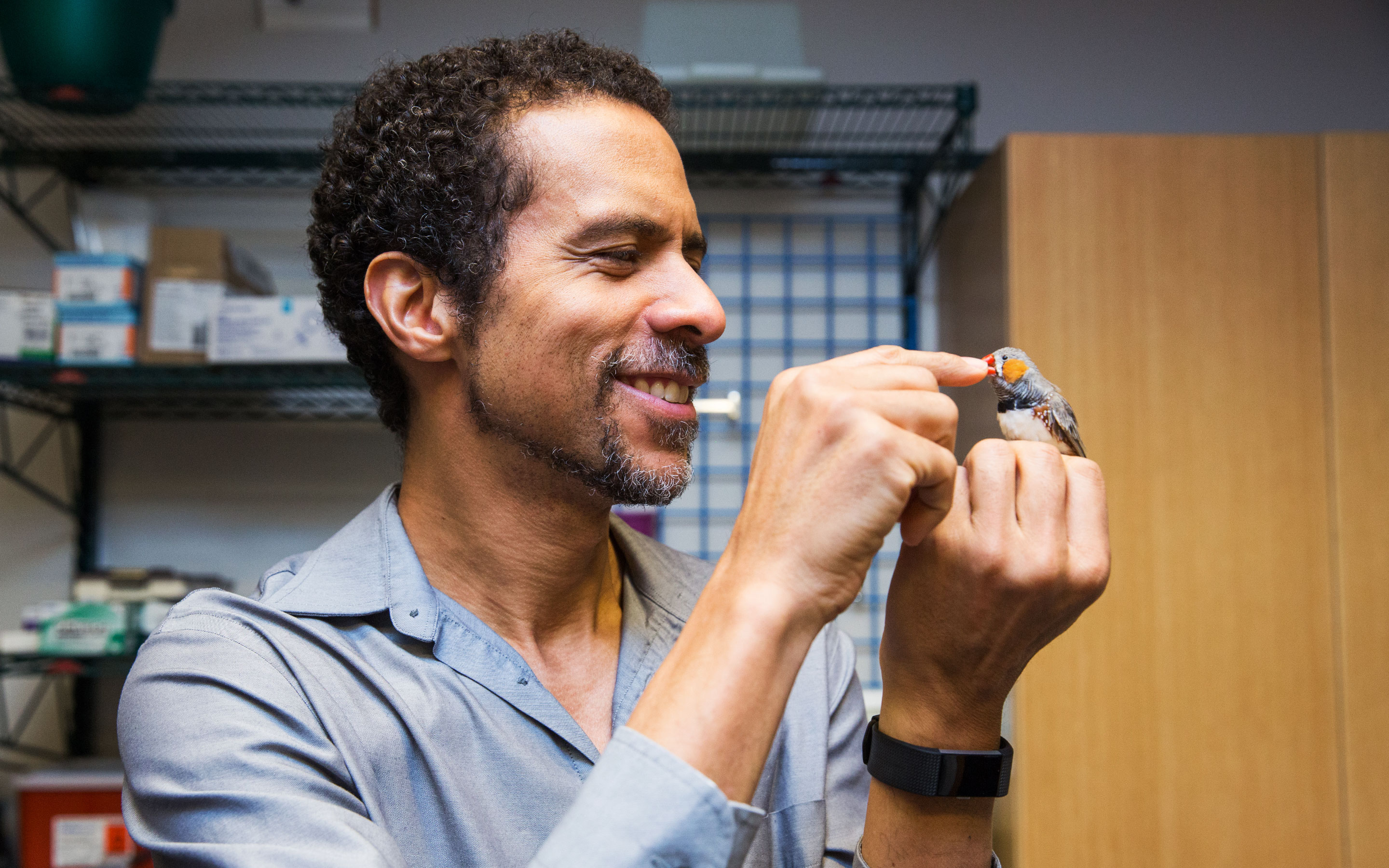
Songbirds are star subjects in the research of Erich Jarvis, a professor at the Rockefeller University who leads its Laboratory of Neurogenetics and Language.
Hatnim Lee for Quanta Magazine
Introduction
When Erich Jarvis, a neuroscientist at the Rockefeller University in New York, won the Ernest Everett Just Award from the American Society for Cell Biology in 2015, he wrote an essay describing the path that led him there, “Surviving as an Underrepresented Minority Scientist in a Majority Environment.” “I believe the evidence will show that the science we conduct and discoveries we make are influenced by our cultural experience,” it begins.
Jarvis grew up in Harlem and started out as a dancer, studying ballet at the High School of Performing Arts and winning several scholarships to pursue that training further. But as an undergraduate at Hunter College, he decided to shift his focus to biology, drawing inspiration from his parents: his mother, who always encouraged him to work for the good of society, and his father, a musician with a passion for science. (While Jarvis was in graduate school, his father, who had struggled with mental illness and homelessness for years, was shot and killed by a teen gang.)
After completing his doctorate at Rockefeller, Jarvis went on to open his own lab at Duke University before returning to New York and Rockefeller in 2016. He has dedicated the past two decades to understanding the neural and genetic mechanisms that allow some birds to imitate novel sounds and produce complex, varied vocalizations (called vocal learning). He’s using those songbirds to illuminate how our capacity for language may have evolved, as well as to provide insights into human speech disorders.
His explorations have involved improving genome assemblies, hunting for parallels between brain structures in different animal groups, and genetically manipulating birds and mice to sing better. Jarvis spearheaded a total rewrite of avian brain nomenclature, which has allowed scientists to better unravel the relationships between the brains of birds and vertebrates. He has led efforts to sequence dozens of bird genomes — something he’s now helping to do for thousands of vertebrate species as a co-chair of the Genome 10K Project — in order to construct accurate evolutionary histories. This work led to one of his major theories: that vocal learning arose independently in songbirds, humans and a handful of other animals when a far more ancient motor-learning pathway in the brain was duplicated.
Quanta Magazine recently spoke with Jarvis about the evolution of vocal learning and language, the influences his parents and his background in dance have had on his academic endeavors, and the need for greater diversity in science. A condensed and edited version of that conversation follows.
What is the difference between vocal learning and language?
Vocal learning is the ability to imitate and learn sounds you hear that you weren’t born producing. Spoken language involves a combination of traits, including vocal learning — which many of us consider the most unique and specialized component.
You can teach dogs to understand the meaning of words like “sit” or “run.” That occurs through auditory learning, the ability to form sound associations with things that you hear. But dogs can’t actually say the sound “sit.” That would be vocal learning.
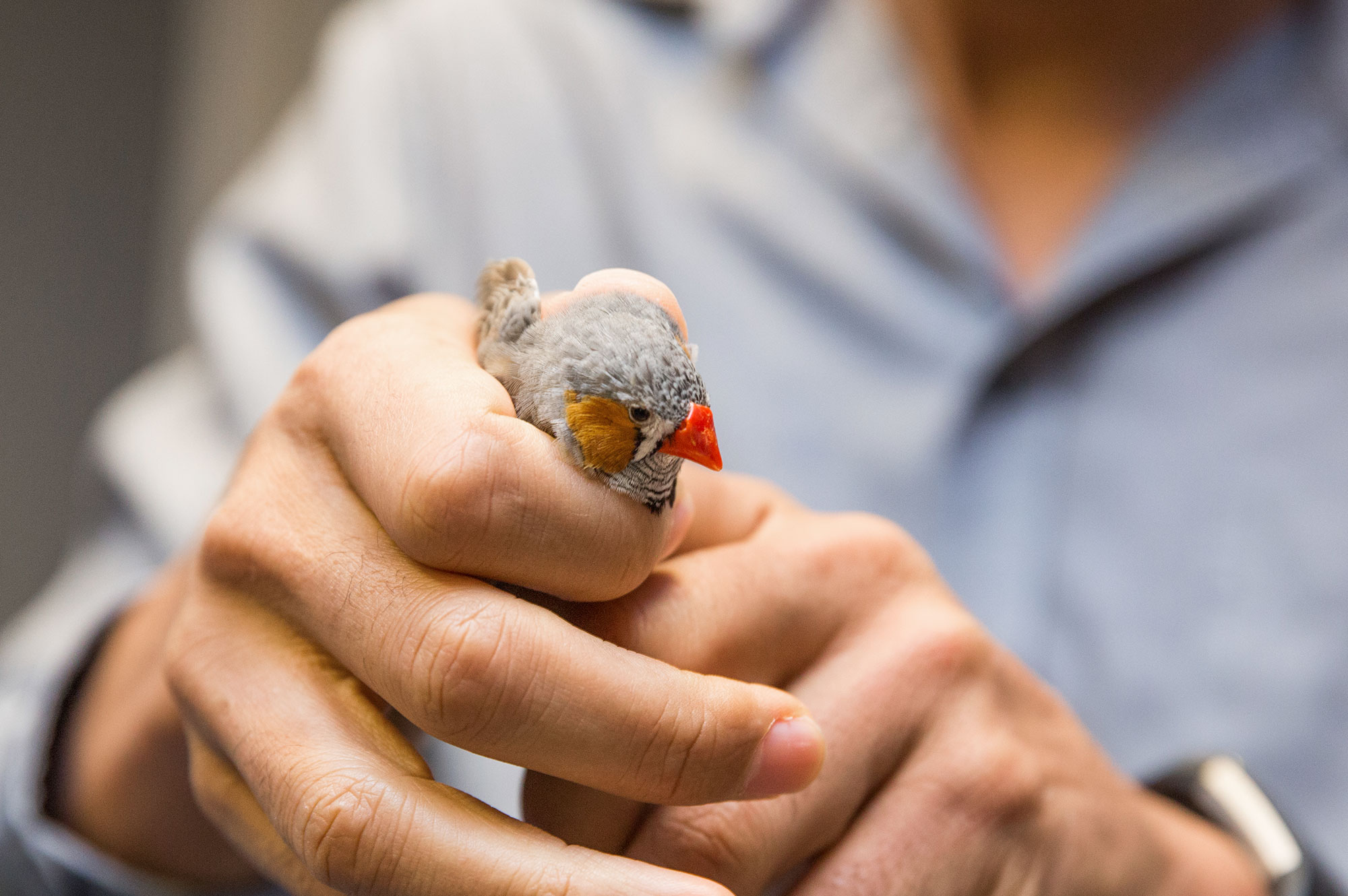
Zebra finches and other songbirds are among the few creatures other than humans that demonstrate vocal learning — the ability to hear and repeat novel sounds that they were not born knowing how to produce. Jarvis has found the neural and genetic underpinnings of this ability, and how they relate to humans’ language talents.
Hatnim Lee for Quanta Magazine
Very few groups of species have vocal learning. Songbirds, parrots and hummingbirds are the only ones amongst birds. There are roughly 40 or so lineages of birds: Those three have it, and the others appear not to. Amongst mammals, besides humans, there are dolphins, whales, bats, elephants and seals.
How did vocal learning evolve, then?
All the species I just mentioned have close relatives that don’t imitate sounds. Like chimpanzees, in our case, or suboscine birds for songbirds. So the vocal-learning groups of species all likely evolved this ability independently. But when we look at the brain pathways they use for vocal learning, they’re similar. They’re embedded within the pathway that controls learning how to move for other muscle groups. So how could that happen if they evolved independently? We propose it’s due to a duplication of that motor-learning pathway during embryonic development. The vocal-learning pathways in humans and these bird groups came from a preexisting structure that has similar connectivity and similar functions — it’s just that instead of controlling muscles for the hands or eyes or feet, this pathway controls muscles that produce sound. Because it had similar ancestry, even though it evolved independently, it inherited similar traits from the surrounding motor areas.
Does that mean there are constraints on how vocal learning — and ultimately, language — can develop, then?
Exactly. A good analogy is the evolution of wings. Wings evolved at least three times in vertebrates: in bats; in birds; in pterosaurs, which are ancient flying reptiles. Each time, the wings evolved on the upper limbs of the body. One constraint is center of gravity. In other words, the wings evolved there because that’s where the least amount of energy is needed to fly. Another constraint is the preexisting substrate of the arms.
For the speech or spoken language pathway, the preexisting substrate is the motor-learning pathway, which was used to control other body parts, not the voice. In fact, we recently found that parrots have two song systems, just as humans have two vocal-learning pathways: In parrots, one pathway is within another, and in humans, the two are near each other. It looks like in the parrot brain there’s been a duplication outside of a duplication.
So why didn’t this happen in more animals?
There are many hypotheses out there. I think something is selecting against vocal learning: predators. We propose that sexual selection is selecting for vocal learning: More varied and diverse kinds of sounds attract the opposite sex. Sexual selection is pretty strong. But if that’s true, why isn’t it more common? We think that predators are selecting against it: Vertebrates’ auditory pathways tune in to changes in sound. And species with vocal learning have a higher ability to keep changing their sounds. So an animal that keeps changing his song is more likely to get a predator’s attention and more likely to get eaten.
But is it unexpected that these duplication events didn’t arise even in related species?
Right, why isn’t it more common? Or, to think about it a bit differently: Can we find some rudimentary circuits? We actually think we are finding some in other species. There’s one suboscine species that we’ve looked at, which looks like it has one of these brain regions partially formed. And in mice, we’re seeing a rudimentary circuit that was thought to exist only in humans among mammals.
This has led us to what we call the “continuum hypothesis of vocal learning.” First, you have the brain stem areas that control innate sounds. Then you get a forebrain vocal-pathway duplication from the motor-learning pathway — but a rudimentary circuit, like what we see in mice. After that, this new duplicated pathway specializes and moves outside of the motor-learning pathway to become its own speechlike pathway, like what we see in songbirds. And finally, it gets duplicated again, to form two or more vocal-learning pathways near each other or surrounding each other, like what we see in parrots and humans. That’s one possibility of what gets us to the ability to produce language through the voice.
What are the implications to finding a rudimentary circuit in a mouse? Does that mean that mice could be on their way to attaining vocal-learning abilities?
Yes, I think it’s possible they could go along to a higher level in the continuum and evolve vocal learning — in the absence of predators. But not necessarily. We’re trying to test that now by genetically manipulating them to go in that direction. Male mice use specific sequences of sounds, mostly in the ultrasonic range, for courtship. So they’re already showing some interesting vocal communication behavior, which has complexity to it. But they can’t manipulate changes to those sounds as well as we can.
We found genetic differences in the speech areas of humans compared to nonhuman primates, and of songbirds compared to nonvocal-learning birds, that we don’t see in the mouse brain. What we’re trying to do is take those specific genes that have these differences in the human brain, put them in the mouse brain’s rudimentary circuit, and see if we can push it to become more like a human’s. We’d like to see if we can train them to change their sound, their pitch, the sequences of vocalizations they produce for food reward. Ideally, we could take one strain of mice that sings one kind of vocalization, and another strain that produces a different kind, and then genetically manipulate one of those groups to see if it could copy the other.
What controls a species’ motivation to imitate sounds?
We proposed a hypothesis, but it needs more fleshing out. Children don’t normally learn spoken language from somebody teaching them how to say something. Rather, they learn how to do it by listening to other people, copying those other people and being rewarded. There’s this social interaction involved. Your parents pick you up and give you a big hug because you said “Daddy” or completed a sentence.
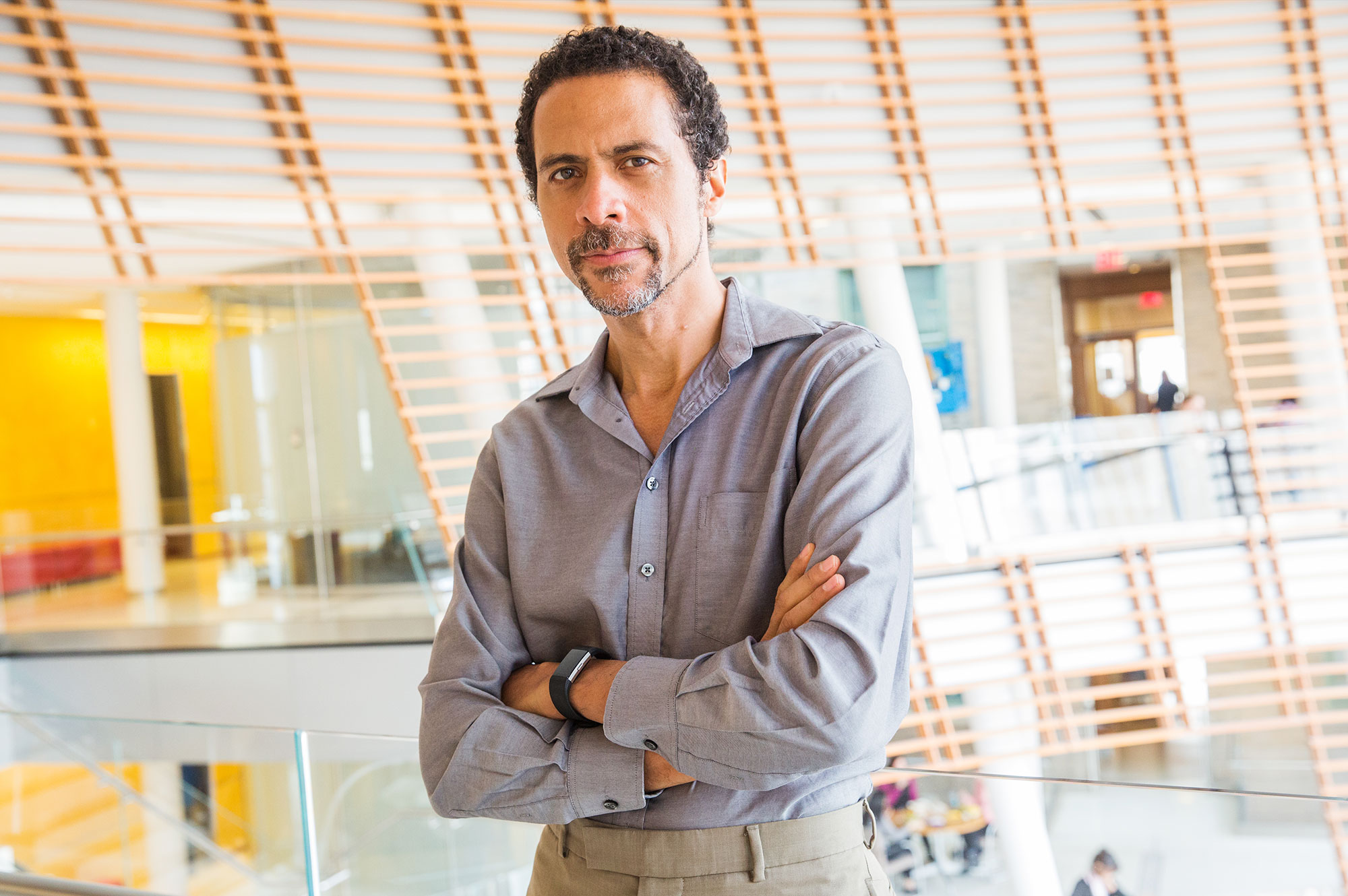
The neural wiring and genetics of various species led Jarvis and his colleagues to propose a “continuum hypothesis” for the origin of vocal learning.
Hatnim Lee for Quanta Magazine
We think this positive feedback is involved in part of the mechanism of vocal learning.
If you raise vocal-learning birds that hear tape-recorded sounds of their own species, but not live animals, they won’t grow up imitating those sounds. They’ll produce something aberrant. But if you give them a living bird — of another species, even — they will imitate that other species. They’d rather imitate a live bird of another species than taped sounds of their own species. Social interaction, and the feeling of getting a reward from another, is determining what you imitate.
That’s why humans aren’t imitating all the songbirds out there. One of the Ph.D. students I’m co-advising, Constantina Theofanopoulou, and I recently published a paper arguing that oxytocin, the bonding hormone, could be controlling the social mechanism of vocal learning. When a child says “Daddy” and is rewarded with a pat on the back or a smile, that gives the child a rewarding feeling. That feeling may release oxytocin into the vocal-learning circuits, to strengthen the memory in the vocal-learning pathway of how to say that sound.
What implications does your research on birds have for human spoken language?
We’ve been studying a gene called FOXP2 that, when mutated in humans, causes a speech deficit. People with the mutation have good auditory learning; they can understand speech relatively well, both cognitively and auditorily. But they have a harder time producing the sounds. And when that gene is knocked out in the songbird brain, they also have difficulty imitating sounds. So we initially thought this was a convergent function of the gene.
But we recently found that when the exact human mutation of the gene is put into the mouse genome, the mice can still produce their vocalizations, they just can’t switch to more complex, innate sequences that females prefer. That makes us think this gene was already there and being used for sequencing of vocalizations, even before advanced vocal learning evolved. Humans and songbirds just depend more on that gene than mice do. It also means that we can use mice and songbirds, along the continuum, as models to study genes involved in spoken language disorders.
But before we get there, we first have to continue studying what the parallel brain regions in songbirds and humans are, what the homologous and convergent cell types are.
So the path you took to get to this point didn’t start with science, but with dance. How did that influence your scientific pursuits?
I started out as a dancer in high school. Most of my family, particularly on my mother’s side, were into the performing arts. I went to the High School of Performing Arts here in New York City, where I majored in ballet. I also eventually did some jazz and African dance. And then, when I was graduating high school, I took the advice my mother gave me all the time growing up: “Do something that has a positive impact on society.” I felt I could do that better as a scientist than as a dancer, and I did like science a lot. But I learned that being trained to become a dancer also trained me to become a scientist.
To be a scientist, you need to have a lot of discipline, which I learned from practicing dance so much; and you need to be creative, something I was prepared for by choreographing dance. You need to accept a lot of failure before you have success. Many experiments don’t work the first, second or ninth time around. It’s the same in dance. And neither is a 9-to-5 job. It’s something that you have to become passionate about.
Are you still dancing?
Yes. I thought I would stop one day, but it hasn’t happened [laughs]. After I got into college, I danced African dance for a number of years, including when I went down to Duke to become a professor there. Then, about six years ago, I switched to doing a lot of salsa dancing, and performed with the Cobo Brothers dance team until I came to New York.
You mentioned your mother’s influence on your decision to become a scientist. What about your father?
So they both actually went to high school in music and arts, to become singers. But my father had a passion for science, and when he went to college he majored in chemistry, until he dropped out after having us four kids, and kind of tuned out of society as well. My parents eventually got divorced. But although I didn’t grow up with him past the age of six, I would see him a lot. And he influenced my thinking: What was he trying to achieve as a scientist? He was trying to understand how the universe works, how civilization began. And in some ways, I felt like I was actually taking up the reins where he left off. His passion did that.
Opportunities for him, as an African-American, were more difficult than they were for me. He felt he was mistreated by some of his teachers, for example. He really studied hard, and skipped two grades in elementary and junior high school. A story he told me before he passed was that he was taken out of a mostly underrepresented-minority school in the Bronx and was put in a mostly white school, and he felt that the teachers resented him and made it harder for him on his exams and so on. That kind of experience has influenced me, how I think about things going forward as a person of color. I’ve felt some of that isolation: Even [as an undergraduate], when I went to international conferences, most of the people were white. And when I went to Duke, even though there’s an even higher population of people of African-American descent in the South, it was quite the opposite on campus. And I started to see what people are thinking. They wouldn’t realize they were saying racially charged things. Like when I was interviewing for graduate school, somebody told me, “Don’t go to that part of New Haven, because blacks and Puerto Ricans are living there, it’s a pretty dangerous neighborhood.” And I’m thinking, “Did I just hear that?” Or I’d be the first African-American to get some award, and someone would [imply that] it was given to me because of the color of my skin.
Like my mother says: “You can’t be as good, you have to be better.” It’s common to hear that as someone from an underrepresented-minority background.
And now that you’re in a teaching position, you’ve been working to develop a program for underrepresented minority students to come and do research at Rockefeller. How have your own experiences shaped your approach?
There are a lot of hardworking people out there with a lot of talent. But if they don’t have the third piece of that equation — opportunity — then their talent and hard work is not going to go far. Hunter College gave me the opportunity. We’ll be working on a program [at Rockefeller] to bring undergraduate students into a high-intensity research institution, into the laboratories of Nobel laureates, to provide them the opportunity as well.
We need to start “fixing the leaking pipeline,” supporting underrepresented minorities as postdocs and faculty to keep them in the sciences. A program was just started by the Howard Hughes Medical Institute to provide fellowships for eight years, called the Hanna H. Gray Fellows Program, named after one of their former board chairs. We have to fix how society thinks. We’re having workshops and classes to discuss things like unconscious bias, creating opportunities for the people affected by those biases to trust their own value. And I also think role models make a big difference.
Having people of diverse backgrounds helps science as well. When there are diverse backgrounds, you do have to manage cultural differences, but those cultural differences also bring different ways of thinking and lead to new ideas — good ideas — that you wouldn’t have thought of otherwise. Diversity generates a broader and more productive scientific operation.
